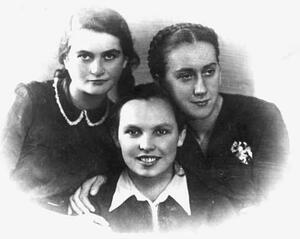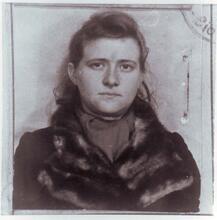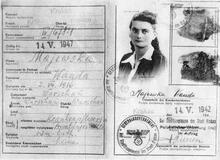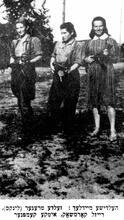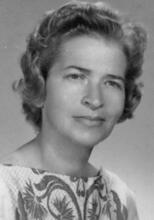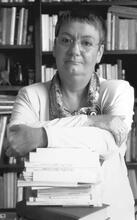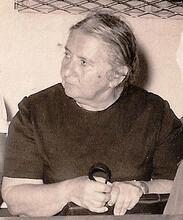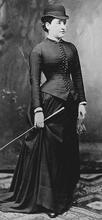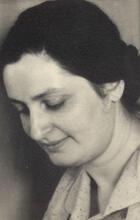Bela Ya’ari Hazan
Courtesy of Yad Vashem, Jerusalem.
Born in Rozyszcze, Poland (now Ukraine), in 1922, Bela Hazan joined the He-Halutz ha-Za’ir-Dror movement as a teen. On the outbreak of World War II, Bela Hazan escaped to Vilna, where she worked as a smuggler for Dror, posing as a Pole. She was arrested by the Gestapo in 1942, though they did not know she was Jewish. She worked as a nurse in various concentration camps, including Birkenau, Auschwitz, Ravensbruck, Malchow, and finally Taucha in Leipzig. When Taucha was evacuated, she stayed behind, escaping with 140 inmates to American forces. She immigrated to Israel, where she died in 2004.
Family and Education
Bela Hazan was born in December 1922 in the town of Rozyszcze (Rozhishche) in the Volhynia region into a family of eight children. Her father, David, who led the prayers in the local bet-midrash, died when she was six, leaving the burden of earning the family’s livelihood to her mother Esther, who owned a small grocery store. The mother sent all the children to a school of the Tarbut network, mainly so that they would gain fluency in the Hebrew language, which was spoken at home. After completing elementary school, Hazan was sent to the ORT vocational school in the city of Kowel, where she supported herself by giving private Hebrew lessons.
Work with He-Halutz ha-Za’ir Dror
A member of the He-Halutz ha-Za’ir-Dror Zionist youth movement, Hazan participated in its seminars and summer camps. In the summer of 1939, the Rozyszcze chapter of the movement sent her to a Haganah course held in Zielonka, near Warsaw. There she made the acquaintance of two prominent members of He-Halutz’s head office: Frumka Plotnicka and Zivia Lubetkin. Upon completing the course, Hazan immediately began serving as a combat instructor at the A voluntary collective community, mainly agricultural, in which there is no private wealth and which is responsible for all the needs of its members and their families.kibbutz hakhsharah (training program) in Bedzin. Three months later, World War II broke out, and in late September 1939 occupied Poland was divided between Germany and the Soviet Union.
In early September, as German forces were approaching Bedzin, the halutzim (pioneers) of the kibbutz fled eastward, but they were forced to return to Bedzin after being outrun by the rapidly advancing Wehrmacht. While struggling to maintain their normal activities under the gory German occupation, they learned that in Vilna, which was still unoccupied, it would be possible to continue the movement’s activities and perhaps even depart from there to Palestine.
At the end of October 1940, a group of ten halutzim, Hazan being the only woman, embarked on a harsh trip, almost 2,000 kilometers long, to Vilna by way of German and Soviet eastern Poland. While crossing the German/Soviet border near Przemysl on the San river, the entire group was captured by Russian soldiers. Suspected of being German spies, they were imprisoned for interrogation. Hazan was separated from the men and released after three weeks. She stayed near the prison while incessantly begging the Russian officers for the release of her comrades. Finally, they were freed and the group continued its voyage. While resting in Kowel, Hazan traveled to her nearby hometown, Rozyszcze, to bid farewell to her family. This was the last time she saw her mother and five of her seven siblings, who were slaughtered in July 1941 by a Ukrainian militia after the town was captured by the Germans at the outset of the Barbarossa campaign. (Hazan's sister, Haya, immigrated to Israel in 1933 and her brother, Urzie, joined the Red Army and survived the war.)
After a long tortuous journey, the halutzim group crossed the Soviet/Lithuanian border in deep snow and reached Vilna on December 31, 1940. They were accommodated in He-Halutz ha-Za’ir-Dror’s kibbutz Shahariyya, where many halutzim escaping German-occupied Poland found shelter.
A Courier for the Resistance
In the latter half of 1941, after the Germans had occupied Vilna and begun murdering the city’s Jews, Hazan, who was “Aryan” in appearance, volunteered to serve as a liaison (courier, or "kasharit") between the various chapters of the movement. She was able to obtain the passport of a Polish acquaintance, Bronislawa Limanowska, and after changing the passport photo Hazan assumed this name for the duration of the war.
Hazan was assigned the task of maintaining contact between the movement’s center in Vilna and the chapters in Lida, Grodno (Hrodna), and Bialystok, smuggling information and relaying bulletins, money, and weapons. After leaving the Vilna ghetto in October 1941, she settled in Grodno and her rented room became a safe place for other Dror couriers traveling between Vilna and Warsaw. Having purchased a crucifix and a Christian prayer book, she visited the church regularly. In Grodno, she also found work as an interpreter for the Gestapo and was given Polish identity papers and traveling permits. She stole official stationery from the Gestapo from which forged documents were prepared by the underground in Vilna. While staying in Grodno, Hazan entered the ghetto and met with members of He-Halutz and the Judenrat, including the Judenrat’s head, Dr. David Braver. She told them of the slaughter of the Jews in the Vilna ghetto. Although the Judenrat members expressed disbelief, its general secretary Zvi Belko gave her money and false papers to assist the escape of Jews from the Vilna Ghetto.
In January 1942, after a group of Dror members (among them, one Yitzhak Engelman) had been smuggled from Vilna to Bialystok, Hazan was asked to transport Shahariyya, Engelman’s six-day-old daughter, from Grodno to Bialystok. Together with Lonka Kozybrodska, a fellow member of Dror who was passing as a Polish woman named Krystyna Kossowska, she smuggled the baby to Bialystok, handing her over to her father. She also transferred to Bialystok another bereaved baby she had found hidden in the Vilna hospital after it has been raided by the Germans. Under her assumed name, Hazan continued on to Volhynia, Luck, and Kowel (Kovel’), meeting at every stop with the remnants of her movement and recounting what was happening in the ghettos of Vilna, Grodno and Bialystok.
Arrest and Imprisonment
In early June 1942, while in Bialystok, Hazan was sent to Warsaw to track the whereabouts of Lonka Kozybrodska, who had disappeared on duty. She was also asked to transport two handguns and a bulletin to the movement’s kibbutz at Czerniakow (Chernyakhuv), near Warsaw. At the border crossing at the Malkinia (Malkinia Gorna) railway station, Hazan was taken off the train and arrested. Gestapo men dragged her to a small detention camp in the forest and interrogated her on suspicion of belonging, under her false Polish identity, to the Polish underground Armija Krajowa (Home Army). Hazan was transferred to the Gestapo headquarters in Warsaw, where she was severely tortured, and was subsequently imprisoned in the notorious Pawiak prison. After lying several weeks in a dark isolation cell, she was moved to a “normal” cell of Polish political prisoners. There she met Kozybrodska, who had also been captured by the Gestapo and imprisoned as a Polish underground activist. From then on, the two were never separated.
During five months of imprisonment in Pawiak, Hazan and Kozybrodska were subjected to starvation, torture, and selections for executions. On November 13, 1942, they were among 52 Polish women prisoners transported from Pawiak to the women's camp in Birkenau (sector BI). Both were sent to work in the fields as part of a forced-labor detail. Hazan was later given work as a practical nurse in the women's hospital, in the barracks housing German women patients, where she cleaned the floors, brought heavy food tanks from the camp's kitchen, and carried the excrement buckets to the latrine. Both Hazan and Kozybrodska contracted typhus and were hospitalized in the same bunk. Hazan recovered; Kozybrodska’s illness gradually worsened, and she came down also with mumps and dysentery. Despite Hazan’s tireless efforts to save her friend, Kozybrodska died in her arms on April 13, 1943.
After Kozybrodska's death Hazan continued to work intermittently in the hospital and in the fields, were she often encountered the cruelty and sadism of the SS guards, overseers and medical doctors. She joined the camp's underground and participated in several of its life-saving activities. At the end of 1944, Hazan was transferred from Birkenau to the new expansion camp for women outside Auschwitz I, where the Polish doctor placed her in charge of the women's infirmary. On January 18, 1945, when the Germans evacuated Auschwitz, Hazan was sent on the forced “death march.” Reaching German soil four days later, she was transported by train along with thousands of fellow prisoners to the women’s concentration camp at Ravensbrück. Shortly thereafter, she was transferred to the Malchow women's concentration camp, near the port city of Lübeck on the Baltic Sea. There she was again placed as a nurse in the women's infirmary. The conditions in the camp were miserable and many women died of starvation, exhaustion, and disease.
On April 3, 1945, Hazan was transported with a group of 1,000 women to the Taucha women's forced labor camp near Leipzig (a subcamp of Buchenwald). On their way, allied airplanes bombed the train, killing many prisoners. In Taucha, Hazan was assigned to the infirmary, where she assisted a Jewish doctor from Prague, Alexander Herman. On April 15, as Allied forces approached Leipzig, the SS evacuated Taucha and took all able inmates on a "death march" through Saxony. Hazan remained with Dr. Hermann in the infirmary to tend the 140 sick inmates who could not join the march. On April 18, as the American army was battling in Leipzig, an SS mobile killing squad was ordered to murder all the inmates remaining in the camps around Leipzig. After massacring several hundred prisoners in the Thekla forced labor camp, the SS squad made its way to nearby Taucha. Two wounded Polish prisoners, who had escaped the Thekla massacre, brought the alarming news to Taucha. Together with Dr. Herman and other prisoners, Hazan orchestrated the rapid evacuation and escape of all sick inmates from Taucha and carried them on a long night journey to the American zone. April 19, 1945, was Hazan's day of liberation.
Liberation
After a short recuperation period in an American hospital in Leipzig, Hazan traveled through Liège, Belgium, to Paris, where she discarded her assumed identity as Bronislawa Limanowska. Soldiers of the Jewish Brigade whom she encountered in Paris drove her in their truck to their headquarters in Tarviso in northern Italy. From there she was taken first to Rome and then to a Jewish DP camp in southern Italy, in the small fishermen's village of Santa Maria di-Bani. For three months, Hazan served as a counselor and teacher for a group of young orphan girls, most of them survivors from partisan family camps. She named the group “Frumka” to commemorate Frumka Plotnicka. On November 4, 1945, the group boarded SS Princess Kathleen, reaching Haifa four days later. After a short internment in the Atlit detention camp, they were taken to Kibbutz Ramat Ha'Kovesh. Hazan stayed with the group for another three weeks to assist their accommodation, after which she was sent by the He'Halutz main office to a convalescence home in Kibbutz Givat Brenner, where she spent a month writing her memoirs. The resulting document, stored in the archive of the Ghetto Fighters House, is one of the earliest testimonies of Jewish resistance and Nazi crimes. It was published in 1991 as a book, They Called Me Bronislawa.
On January 5, 1946, Hazan married Haim Zaleshinsky (1911-1982), a Jewish Brigade veteran and a journalist she had previously met in Rome. Zaleshinsky changed his surname to the Hebrew name Yaari. They lived in Kibbutz Glil Yam for a year and then moved to Tel Aviv. The couple had two children, Esther (b. 1947) and Yoel (b. 1949). Hazan passed away on January 18, 2004, in Jerusalem.
In May 2018, Hazan was posthumously awarded the "Jewish Rescuer Citation," conferred by the B'nai B'rith International organization, in "recognition of the devotion, courage and heroism exhibited in rescuing fellow Jews during the Holocaust."
Bender, Sara. The Jews of Białystok During World War II and the Holocaust. Hanover, NH: University Press of New England, 2008.
Gromb, Moshe. Jews who rescued Jews During the Holocaust. Tel Aviv, Nadav Books, 2020.
Hazan Ya’ari, Bela. They Called Me Bronislawa. Tel Aviv: Ha'Kibutz Ha'Meuhad, 1991. (Hebrew).
Klibanski, Bronka. Ariadne. Jerusalem: Halonot Publishers, 2002. (Hebrew).
Tek, Nehama, Resistance, Jews and Christians Who Defied the Nazi Terror. Oxford: Oxford University Press, 2013.
Zik, Gershon, ed. Rozyszcze, My Old Home. Tel Aviv: Association of Rozyszcze Jews, Achdut Press, 1976. (Hebrew).
Zilberscheid, Ya’akov, and Arye Fialkov, ed. Tel Hai: A Hakhsharah Kibbutz in Poland. Tel Aviv: Ha'Kibutz Ha'Meuhad, 1979. (Hebrew).

